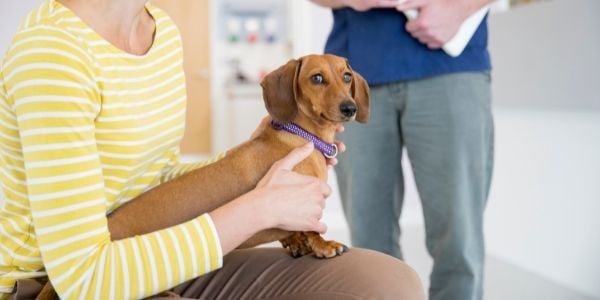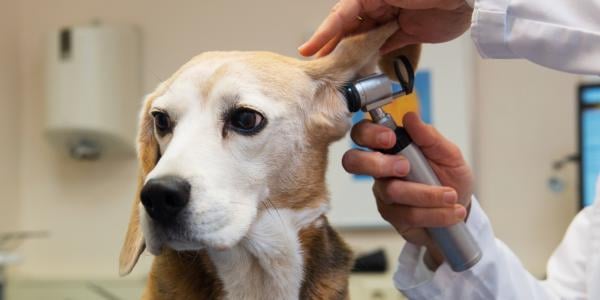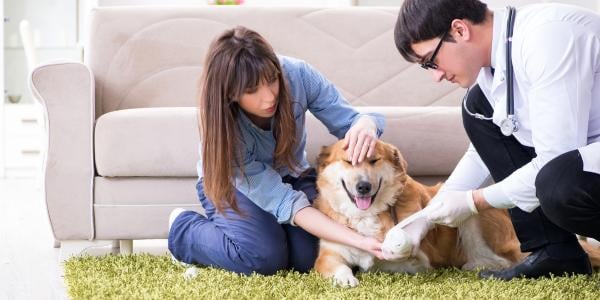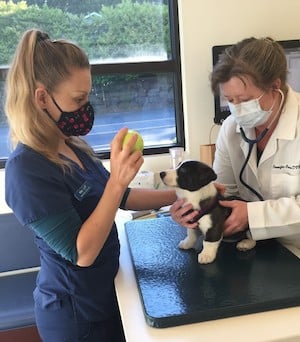
If your dog gets overwhelmed at the veterinary clinic, going in for an exam or an emergency can be a daunting experience. Your dog may start shaking, panting, and drooling from anxiety when you turn into the parking lot. Or they may start acting aggressively out of fear when approached by veterinary staff.
Why do dogs get so scared going to the vet? For many dogs, the vet clinic is associated with pain and fear — which makes sense.
A lot of what they experience there involves exams of painful areas, getting their temperature taken (which does not involve a thermometer under the tongue…), and getting vaccinations. The first experience at a vet clinic often happens during early puppyhood, during the important socialization period. If they have a negative experience, it can stick with them for life.
There are several things you can do to make vet visits as low-stress as possible for your dog and ensure that they receive the best possible care. Investing the time into making vet visits a more positive experience will pay off in many ways — less stress for your dog, less stress for you, and increased safety for the veterinary team!
Why Do Dogs Hate Going to the Vet?
Many dogs do not have great experiences during their veterinary exams. They don't understand what's happening and why someone they aren't familiar with is invading their personal space. These negative experiences add up over time, and a dog may get more and more fearful or anxious with each vet visit. A dog may get sick or injured and have just one traumatic experience at the vet, which they associate with pain. This can even counteract years of good experiences at the vet.
Dogs, like humans, exhibit anxiety and fear when they sense their safety is threatened or don’t know what’s happening. Sometimes that fear is obvious to us, with shaking, drooling, excessive panting, hiding, or trying to run away. But fear also causes dogs to act aggressively as a defense, especially if they can’t run away – no flight option leads to picking the fight option!
Your dog is not trying to be bad. They are not trying to be dominant. They are simply struggling with the process of being examined or treated by the veterinarian or vet staff.
Imagine if someone took you to an unfamiliar place and held you down while they gave you an injection (without any warning or explanation beforehand). You’d probably be pretty freaked out, too, panicking or trying to escape, even if that meant punching a few people to get away.
Find a new veterinarian or trainer if anyone recommends heavy restraint, pinning or holding your dog down, or any kind of punishment for exhibiting fearful or anxious behaviors. Being forced to participate in a process that scares your dog only feeds into their fear and causes increased fear responses the next time. It’s better to rely on sedation with pre-visit medications than to manhandle a dog to get medical treatment done.
A veterinary clinic that stops non-essential treatment to prevent further stress or anxiety in a dog is a vet clinic that I fully support. They may send you home with a plan for pre-visit medication for next time or schedule you for another day to finish what they started. While this may be frustrating or inconvenient for you, it shows that they prioritize your dog’s mental well-being and safety for all.

How to Help Your Dog Feel Better About Vet Visits
Plan Some Happy Visits to the Vet
Take your dog in for semi-regular visits to the vet’s office outside of scheduled appointments. This helps your dog become familiar with the clinic environment and gives you a chance to associate going in with good things happening. While this is especially helpful for puppies during their socialization period, it can be beneficial for dogs of all ages.
If your dog exhibits severe anxiety at the vet, happy visits may be a part of your behavior plan, but it's best to only do them if recommended by your behavior consultant.
This may mean only going for short visits to the vet clinic parking lot at staying in the car at first, before adding in getting out of the car, etc.
Don’t just show up for a happy visit without first checking with your vet. Give them a call to ask the following:
- Do they allow happy visits at their clinic?
- What’s the best time to drop in for a happy visit?
- Should you call ahead or just stop by?
- Any particular “no-go” zones in the lobby besides the obvious? (Do not let your dog approach other dogs or pets anywhere in the lobby or outside the clinic in the parking lot.)
Keep these happy visits at the vet clinic short and sweet – just a few minutes is perfect! Practice a couple of training skills in the parking lot, then spend a minute in the lobby where your dog gets cookies for just hanging out. Have them step on the scale to get a treat, and, if possible, have vet clinic staff give them attention and treats. Then leave and go about your day as usual.
Go at your dog’s pace! If, during a happy visit, your dog exhibits any signs of anxiety or fear, stop what you’re doing and leave. Then think about what in the environment might have triggered that anxiety so you can pinpoint with a certified professional trainer or behavior consultant where to start your dog’s behavior plan.
Here's a great video showing a happy visit with an adolescent German Shepherd, where they also work in some great counterconditioning exercises:
Things to Do Before Your Dog’s Vet Appointment
Choosing the right veterinary clinic is crucial in helping your dog during their appointments. Look for a clinic that is committed to low-stress handling and fear-free techniques. A clinic that prioritizes the safety and well-being of their patients is better than one that will do whatever is needed to “get it done.”
- Call your vet's office and discuss how to best set up the appointment for success. This may include having you and your dog wait in your car rather than the lobby, or they may schedule you as the first or last appointment of the day to ensure a calmer environment.
- Leave yourself plenty of time to get to the clinic. Aim to leave your home 10 minutes earlier than you think you need and prepare everything for your trip several hours in advance. This helps minimize your stress, which in turn, helps your dog be less stressed.
- If you're driving, safely restrain your dog in the car for the trip to (and from) the vet’s office. This isn’t only a safety issue, but it can also help your dog feel more secure and decrease the anxiety they may feel during car travel. Read other tips for decreasing travel anxiety (and car sickness) in pets.
- Spray ThunderEase Adaptil, a calming pheromone for dogs, in your dog’s crate or on their harness and seat within the car. Consider adding a favorite blanket or toy that smells like home so your dog has another soothing scent nearby.
- Consider calming supplements if your dog exhibits low-level anxiety symptoms.
- Play calming music in the car on the way to the vet’s office and crack the window or turn on the air conditioning for airflow.
Help for Dogs That Are Especially Stressed During Vet Visits
For dogs who get particularly stressed during trips to the vet, continue doing the above but also talk to your veterinarian about possible pre-visit medication options you can give at home. There are quite a few options that are extremely beneficial to lower your dog’s anxiety about the vet. It’s better to have your dog take these to prevent a bad experience than to explore them after the fact (when your dog has already experienced a negative association).
Learn more about anxiety medications for dogs here and download a free medication chart to talk about with your vet.
Symptoms of anxiety in your dog include:
- Not taking high-value treats
- Yawning
- Panting and Drooling
- Trembling
- Expressing their anal glands
- Trying to escape
- Aggressive behaviors like growling, air snapping, or biting
Check out this video for some examples of stressed body language at the vet clinic:
Consider a Mobile Vet Service
If your dog shows high levels of anxiety, fear, or aggression at the vet clinic, finding a mobile vet who can come to your home for exams may be best. Search in your area for a mobile vet or ask for a referral from your current veterinarian. However, if your dog struggles with allowing guests into your home, this may be equally stressful and has more safety risks.

Practice Counterconditioning for Vet Exams
You can significantly desensitize your dog to vet procedures with a little conditioning. Give your dog positive experiences by introducing handling techniques and practicing cooperative care at home. This type of training is crucial for puppies for their overall socialization and for
For basic counterconditioning, you want to simply pair being touched and handled with things your dog finds particularly rewarding, such as high-value dog treats. Not plain ol’ kibble – think turkey hotdogs or dog-safe peanut butter.
- Gently touch your dog’s ear
- Then give them a high-value treat or lick of peanut butter
- Repeat
Never go too fast in this process. Some dogs have to start with just a hand slowly coming toward their head before they get a treat, rather than being touched at first. As they get more comfortable with the process and start having a more positive emotional response, then you can move on to the next step, such as lifting your dog's ear and looking inside.
Many different training skills make up cooperative care, so it’s important to get a tailored plan for your dog that addresses their needs and background. For example, a dog who requires frequent blood draws for monitoring will need different skills than a dog who needs to be treated for frequent ear or skin infections. A dog who exhibits aggressive behaviors out of fear will need a different approach than an overexcited wiggly dog.
Watch this video to see how cooperative care training made cleaning a dog's ear easy and stress-free:
Another great cooperative care skill for all dogs is learning how to wear a basket muzzle. Not only does this increase safety for the veterinary team, but it can also act as a stress relief for your dog if introduced positively and properly. Find out how to muzzle train your dog here.
Connect with a certified professional dog trainer here to get a personalized cooperative care plan for your dog.
 Work With Your Dog’s Veterinary Team
Work With Your Dog’s Veterinary Team
Having a good relationship with the vet and clinic staff can make all the difference in your dog’s stress levels. Take time to talk to the vet and staff about your dog’s anxiety triggers and any special needs. Tell them if your dog has tried to bite in the past when nervous or overwhelmed so they can act accordingly.
Advocate for your dog and be willing to ask questions if you don’t understand any treatment procedures. Also, don't be afraid to ask about alternative approaches or sedation options if necessary.
It is completely okay to comfort your dog during vet visits! However, manage your anxiety levels and keep your tone of voice calm and relaxed. If you start to sound worried (which often makes people talk faster and at a higher pitch), then your dog will feed off of that. But if they see and hear you being cool, calm, and collected, it can help them feel better. Read more about how human body language affects dog behavior.
Often you will be asked to step back from your dog while the veterinary team works with them. This isn't personal – it's due to safety reasons and liability issues in case a dog bites. Follow your veterinary team's instructions as far as where to stand or whether you can touch your dog during the exam. In some cases, dogs actually do better when their owner is not present, so your vet team may ask if they can take your dog in the back or if you can wait in the lobby. As long as you trust your veterinary staff, this is a great option to test out.
Bring along your dog's favorite high-value treats, such as a Toppl interactive toy stuffed with wet food and peanut butter (as seen in the picture above with my dog at his first vet visit) or a squeezable treat like a Bark Pouch or a DIY treat tube version.
After Your Dog’s Vet Visit
Beyond following any treatment or care instructions from your vet, remember to provide decompression time and activities for your dog after their vet visit. Specific calming activities can help them relax. Don’t plan other outings or potentially stressful experiences for the same day as a vet visit (such as meeting another dog, training class, having guests over, or anything else your dog gets overstimulated by or anxious about).
Vet visits are an essential part of your dog's health, and by following these tips, visits can be less distressing for everyone involved. The more you prepare, communicate, and familiarize your dog with the vet environment, the easier future visits will become.
How does your dog do at vet visits? Do they love it? Hate it? Let us know in the comments below!




